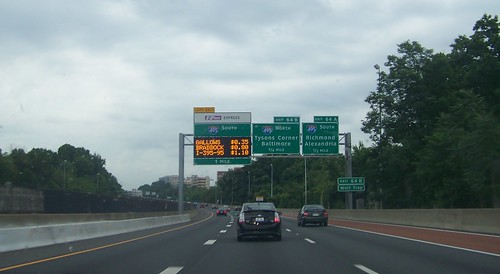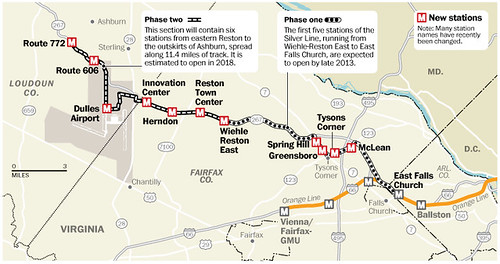Road building, induced demand, and tolls
It's a well accepted principle in transportation planning that if you build more roads and lanes, after a period of congestion improvement, congestion again increases as more people make more trips. This is called "induced demand."
Right: graphic on length of time improvements from driving trips on the I-495. Source: Inrix Traffic. Laris Karklis and Bonnie Berkowitz/The Washingon Post.
So it's possible that the report in the Washington Post ("Drivers see less congestion on area roads") that with the addition of High Occupancy Toll lanes in Northern Virginia and the tolled Inter County Connector in northern Montgomery County, along with general declines in driving per capita ("The End of Car Culture" from the New York Times) that pre-date the recession, is merely a blip resulting from current conditions, and one can't extend from it--especially if/when the economy picks up.
On the other hand, I wonder if there is a wrinkle to the general induced demand argument.
It's true that as long as it's basically free to consume a resource once you have acquired the means to do so (in this case a car) people will consume as much of it as they can.
 Congestion is a non-cash expense that influences decisions people make about when and how and whether or not to make trips.
Congestion is a non-cash expense that influences decisions people make about when and how and whether or not to make trips.A perfect example is recounted in the Post article, describing how a woman working in Rosslyn got a job much closer to home. This is a positive benefit of congestion as it "encourages" (choice) people making better decisions about how to use their time, where to work, to take transportation costs into account when making choices, etc. From the article:
“It absolutely was a factor,” said Jennifer Hoh, describing her decision to take a job with a 20-minute rush-hour commute in Reston. It took about an hour and a half on traffic-snarled roads to reach her previous job in Rosslyn. “Now work is a nine-hour day,” she said. “When I was in Rosslyn, the commute made it a 12-hour day.”
But what if the increase in road capacity is tolled, rather than free?
Can selective road expansion reduce congestion without necessarily increasing demand and the overall number of trips?
It's a question worthy of more study. With regard to the article there are four issues and I guess you'd have to do more complex statistical analysis to separate out the effects:
1. reduced driving overall;
2. reduced driving due to the economic downturn;
3. people making better location decisions concerning trip times/length;
4. additional road capacity that is tolled as opposed to being untolled.
 Right: Silver Line station map. Washington Post graphic.
Right: Silver Line station map. Washington Post graphic.And an additional factor is being introduced to the region, with the provision of direct subway connection to the Tysons Corner area, the largest employment center in the metropolitan area outside of DC. While it will take a couple years to play out, having subway connections to that area will increase the number of trips but also will shift some trips to transit, thereby contributing to congestion reduction as well.
This is the case even though the trip time to get to Tysons by transit will be long and not cheap (especially during rush periods).
From the New York Times article:
But America’s love affair with its vehicles seems to be cooling. When adjusted for population growth, the number of miles driven in the United States peaked in 2005 and dropped steadily thereafter, according to an analysis by Doug Short of Advisor Perspectives, an investment research company. As of April 2013, the number of miles driven per person was nearly 9 percent below the peak and equal to where the country was in January 1995. Part of the explanation certainly lies in the recession, because cash-strapped Americans could not afford new cars, and the unemployed weren’t going to work anyway. But by many measures the decrease in driving preceded the downturn and appears to be persisting now that recovery is under way. The next few years will be telling.
“What most intrigues me is that rates of car ownership per household and per person started to come down two to three years before the downturn,” said Michael Sivak, who studies the trend and who is a research professor at the University of Michigan’s Transportation Research Institute. “I think that means something more fundamental is going on.”
Labels: car culture and automobility, congestion pricing, tolls, transportation planning




1 Comments:
Nice post.
Visit here -generic ed drugs
Post a Comment
<< Home